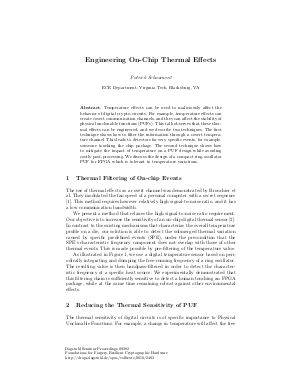Engineering On-Chip Thermal Effects
Author Patrick Schaumont
-
Part of:
Volume:
Dagstuhl Seminar Proceedings, Volume 9282
Part of: Series: Dagstuhl Seminar Proceedings (DagSemProc) - License:
 Creative Commons Attribution 4.0 International license
Creative Commons Attribution 4.0 International license
- Publication Date: 2010-01-13
File

PDF
DagSemProc.09282.5.pdf
- Filesize: 137 kB
- 2 pages
Document Identifiers
Subject Classification
Keywords
- PUFs
- temperature effects
- covert temperature channel
- ring oscillator PUF
- FPGAs
Metrics
- Access Statistics
-
Total Accesses (updated on a weekly basis)
0Document
0Metadata
Abstract
Temperature effects can be used to maliciously affect the behavior of digital crypto-circuits. For example, temperature effects can create covert communication channels, and they can affect the stability of physical unclonable functions (PUFs). This talk observes that these thermal effects can be engineered, and we describe two techniques. The first technique shows how to filter the information through a covert temperature channel. This leads to detectors for very specific events, for example, someone touching the chip package. The second technique shows how to mitigate the impact of temperature on a PUF design while avoiding costly post-processing. We discuss the design of a compact ring-oscillator PUF for FPGA which is tolerant to temperature variations.
Cite As Get BibTex
Patrick Schaumont. Engineering On-Chip Thermal Effects. In Foundations for Forgery-Resilient Cryptographic Hardware. Dagstuhl Seminar Proceedings, Volume 9282, pp. 1-2, Schloss Dagstuhl – Leibniz-Zentrum für Informatik (2010)
https://doi.org/10.4230/DagSemProc.09282.5
BibTex
@InProceedings{schaumont:DagSemProc.09282.5,
author = {Schaumont, Patrick},
title = {{Engineering On-Chip Thermal Effects}},
booktitle = {Foundations for Forgery-Resilient Cryptographic Hardware},
pages = {1--2},
series = {Dagstuhl Seminar Proceedings (DagSemProc)},
ISSN = {1862-4405},
year = {2010},
volume = {9282},
editor = {Jorge Guajardo and Bart Preneel and Ahmad-Reza Sadeghi and Pim Tuyls},
publisher = {Schloss Dagstuhl -- Leibniz-Zentrum f{\"u}r Informatik},
address = {Dagstuhl, Germany},
URL = {https://drops.dagstuhl.de/entities/document/10.4230/DagSemProc.09282.5},
URN = {urn:nbn:de:0030-drops-24032},
doi = {10.4230/DagSemProc.09282.5},
annote = {Keywords: PUFs, temperature effects, covert temperature channel, ring oscillator PUF, FPGAs}
}
